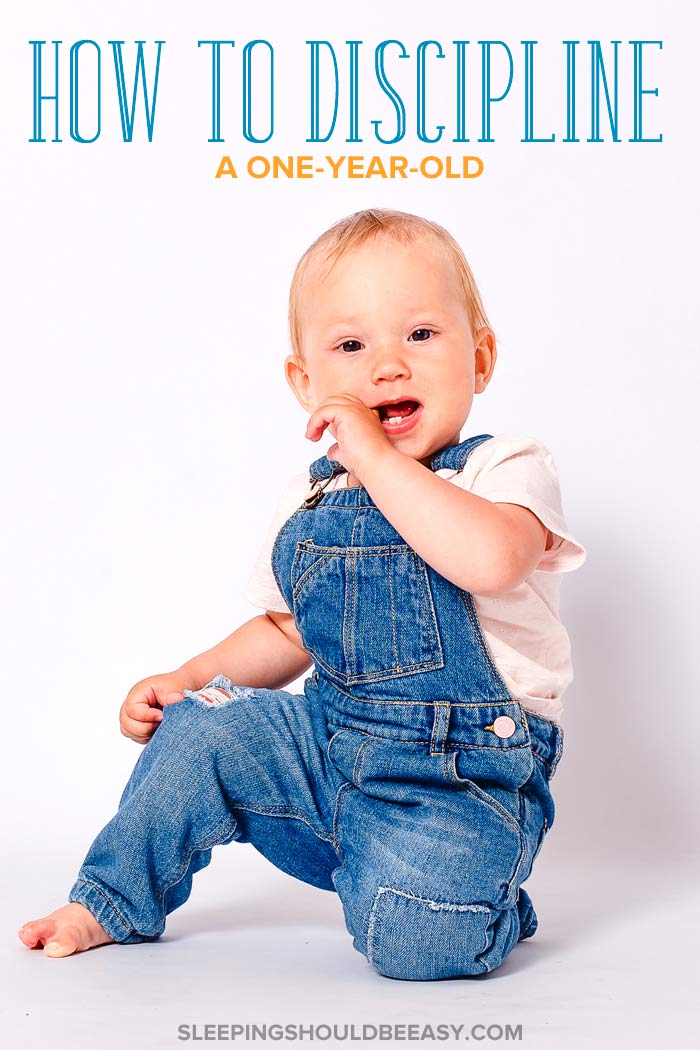How to Discipline a 1 Year Old
Wondering how to discipline a 1 year old who hits and throws tantrums? Discover techniques that can help toddlers behave, even at this age.
 As a first-time mom, I wasn’t exactly sure if I was supposed to be disciplining my 1 year old.
As a first-time mom, I wasn’t exactly sure if I was supposed to be disciplining my 1 year old.
He was starting to do things he knew he shouldn’t be doing, from banging on the glass doors to yanking on the blinds (complete with a smirk on his face). Yet, despite the constant reminders, he still did them anyway.
While he was no longer a baby, he wasn’t able to communicate the way older kids could, either. How are you supposed to tell a 1 year old “no” and have him understand?
Later, I learned I was not alone. Many parents have no idea how to discipline a 1 year old or whether to do so to begin with.
You may have tried time-outs, but your child ended up loving it (and even stood on the chair). She knows she’s not supposed to climb the stairs, but does it anyway (even when you give her a firm “no”). How do you let her know that her unwanted behavior isn’t appropriate?
Rest assured, friend, you’ve come to the right place. I learned that disciplining a 1 year old isn’t exactly the same as disciplining older kids. At this age, they still have no impulse control to make better decisions.
In other words, sometimes they just can’t help it.
Still, that doesn’t mean you can’t begin to discipline. But first, understand that “discipline” isn’t punishment, timeouts, or spanking—it’s teaching. Use her challenging behavior as an opportunity to teach her how to behave in a firm yet loving way. Here’s how:
Table of Contents
1. Redirect to a similar and appropriate activity
My son wanted to climb on the TV table—not exactly the safest activity. But rather than saying, “Don’t climb,” I learned to redirect him to a similar but more appropriate activity. I said, “Let’s not climb on the TV stand—the glass can break. But let’s practice climbing on the couch.”
You see, 1 year olds are more curious than defiant. They’re practicing skills and exploring their world, unaware that climbing the TV table isn’t as safe as climbing on the couch. Climbing isn’t bad per se, but it isn’t always safe in every circumstance.
Honor your child’s impulse to climb, draw, or throw by redirecting her to an activity that allows her to do just that in a safe environment.
Free resource: Are your current discipline methods not cutting it with your toddler? Learn 9 discipline strategies that can help you deal with her behavior. Imagine transforming your relationship using just the tips you can learn right here. Join my newsletter and grab your PDF below:
2. Move your child to a different location
Granted, redirection isn’t always possible or even appropriate. If your toddler hits you in the face, you don’t redirect her toward something else she can hit.
In that case, moving her to a different location is the first and necessary step. Perhaps she’s overstimulated by the environment or she’s about to hurt someone or break something. She might just need to crumble in your arms and cry, away from the situation that triggered her behavior.
Still, that doesn’t mean she can’t learn something valuable. If she hit another child, acknowledge her emotions (“You felt mad that he took your toy”) and show empathy (“I’d feel mad, too”). Then, explain why the behavior is wrong (“We don’t hit because it hurts”) and what she can do instead (“Next time, say ‘Stop'”).
3. Babyproof your environment
Slash the number of times you say “no” by preventing the misbehavior to begin with. Think of the times you’ve told your child to stop playing with the phone when you could’ve tucked it out of reach. Or those times you have to keep moving him away from the stairs when a simple baby gate would do the trick.
Hearing “no” constantly can be hard for any 1 year old. Instead, make your home a “yes” environment by setting it up for him to explore. You see, it’s good that he’s curious and “getting into things”—he just needs safe and appropriate things to get into.
You might even take him to places where exploration is encouraged, like hands-on museums, mommy-and-me lessons, and age-appropriate gym classes.
4. Use these as opportunities to teach
As important as it is to tell your 1 year old what not to do, use these opportunities to teach him what to do instead.
Show him how to climb down safely from the couch, gently pat the dog, or feed himself finger foods. This is the time to learn these basic skills and make better choices. Every misbehavior is a chance to show him the proper way to behave.
Want to take it up a notch? Focus more on telling him what to do, instead of what not to do. “Walk” or “Be gentle, like this” are more effective than “Don’t run” or “Stop yanking.”
5. Give positive attention for good behavior
Don’t just correct your child when he makes poor choices—praise him just as much for the times he makes good ones.
Kids continue to do what gets them attention—whether positive or negative. The constant “no’s,” and the reactions they get only encourage them to keep doing the very behaviors we’re trying to correct.
Let’s say your child walked to the front door to put on his shoes without you have to nag. He might continue doing so if you say, “Look at you, walking to the front door all on your own!” Even a simple hug and kiss sends the message that this is something that deserves attention.
Praising positive actions also reminds you that tough times aren’t always so tough. Even if it feels like he misbehaves all the time, you have evidence that he doesn’t. Remembering how far he has come along reminds you that you have more good moments than you give yourself credit for.
Yes, you’re more likely to notice when he’s screaming than quietly playing, but start to notice positive behavior. A simple “Thanks for playing on your own while I prepare dinner” is enough for him to know that what he’s doing is pretty darn good in your book.
6. Find the underlying reasons
As much as it may seem like your 1 year old is out to push your buttons, more than likely, he’s responding in ways he knows how. He isn’t able to say, “I’m tired from being out all day.” Instead, he might throw a fit and refuse to sit still in the grocery cart.
What could be triggering him to misbehave? Could he be exhausted and hungry, or overwhelmed by all the visitors he’s met? Perhaps he’s too young to meet your expectations, like being out most of the day on errands or following a string of instructions for the first time.
Expert tip
Use these opportunities to connect with him. Now that you know the possible triggers, you can say, “You’re pretty tired from being out all day. Let’s go home and snuggle on the couch now.”
7. Stay calm
Rather than trying to change your child’s behavior, focus on staying calm. Yes, it’s so easy to react with anger when she’s driving you nuts. But here’s the thing: you need to hold your ground.
You see, these tantrums scare her. If her own parents can’t help her through her meltdowns, then who will?
Besides, staying calm is more effective in getting her to listen than yelling. Think about the last time you yelled versus having stayed calm. No matter how difficult it was to keep your anger at bay, her tantrum probably ended a whole lot faster than when you yelled.
Now is the time to give her love and compassion, even as you set firm and clear boundaries. You really can be consistent with your expectations and be kind at the same time.
Conclusion
Disciplining a 1 year old can be a challenge, especially when your child is no longer a “baby” but still not one of the “big kids.” After all, her understanding of the world is still growing, as is her curiosity and desire to explore.
Still, you can discipline at this age when you remember that “discipline” is teaching, not punishment.
Redirect her to a similar but more appropriate activity or move her to a new location. Babyproof your environment to prevent telling her “no” all the time. Use these opportunities to teach and model how to behave, rather than focusing so much on what not to do.
Offer positive reinforcement when you catch her behaving well. Find underlying reasons she may be behaving this way. And most important, stay calm. You’re better able to respond intentionally rather than reacting to her every antic.
I knew I was entering the toddler stage when my no-longer-a-baby kiddo kept getting into things he wasn’t supposed to. But I also learned that disciplining at this age is still possible—even if he bangs on the glass doors with a smirk on his face.
Get more tips:
- What to Do When You’re Seeing 1 Year Old Tantrums Already
- How to Discipline a Toddler Who Hits
- How to Get Things Done with a Toddler
- How to Give Consequences for Kids
- 5 Things to Remember When You’re Losing Your Temper with Your Toddler
Don’t forget: Sign up for my newsletter and grab your PDF below—at no cost to you:




